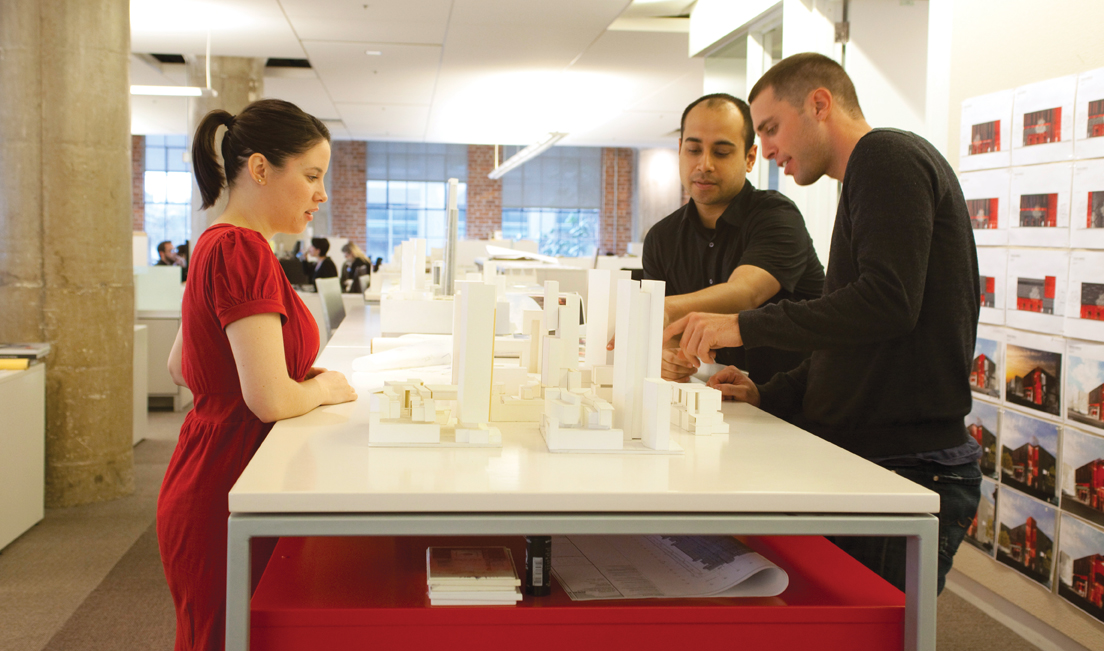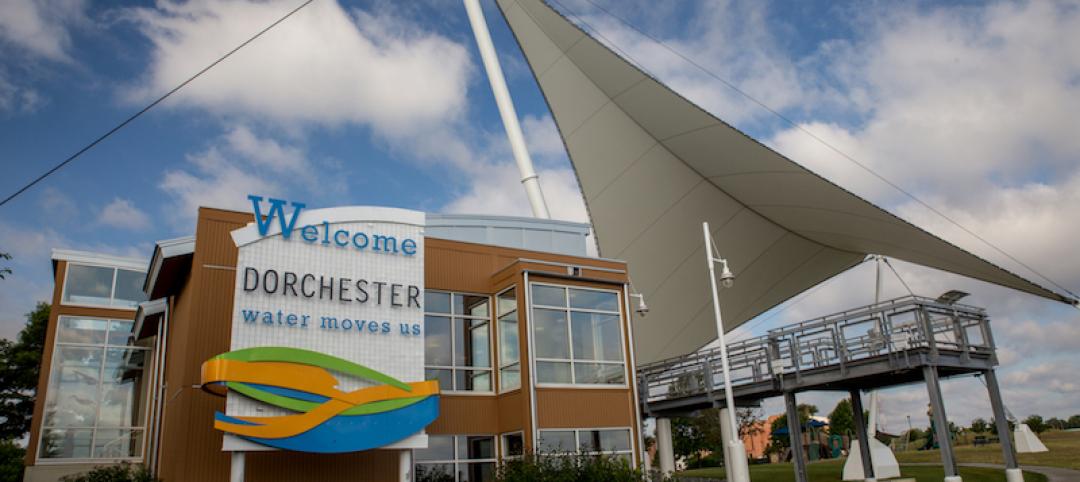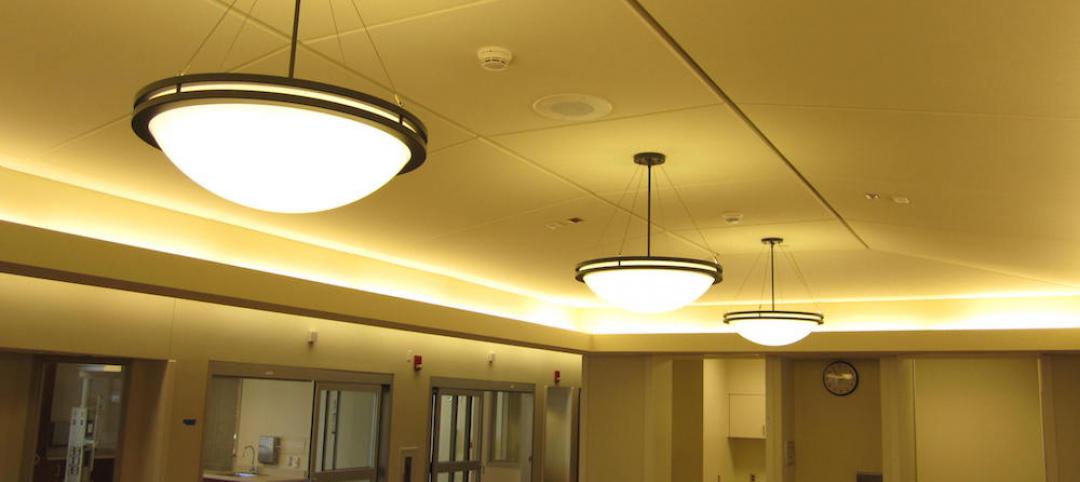With FY2011 revenues of $574 million and more than 3,000 employees in 41 offices serving 2,248 clients in 90 countries across North and South America, Asia, and the Middle East, Gensler can certainly lay claim to being the largest architectural firm in the world. What makes it truly distinctive, though, is not its size but its culture, a culture built from its founding nearly 47 years ago on collaboration, innovation, and, most important, client service. These are the qualities that make Gensler a “Best AEC Firm to Work For.”
From modest beginnings as a three-person firm in 1965, Gensler has grown spectacularly over nearly five decades, surviving numerous economic roller-coaster rides that have jostled the architecture profession—most recently, the boom and bust of the last decade, when firm revenues went from $256 million (FY2003) to a high of $697 million (FY2009), then dropped precipitously to $463 million in FY2010.
It was in the midst of this tumultuous period that the firm made its transition from the guiding hand of founder M. Arthur Gensler, Jr., FAIA, FIIDA, RIBA, to a new generation of shared leadership under three Executive Directors: Andy Cohen, FAIA; David Gensler, Assoc. AIA, LEED AP, Art Gensler’s oldest son; and Diane Hoskins, FAIA, LEED AP. They are supported by six additional members of the Board of Directors and a Leadership Council of about 100.
When it comes to client relationships, Gensler’s roots go deep. “I would put three lines under that, with exclamation points,” says Hoskins. “The better the client relationship, the better the design opportunity. The client relationship unlocks the synergy that leads to great work. If you start with a blank sheet of paper and really listen to and embrace what your client needs, you’re going to come up with something that’s never been done before.”
That “client-centered” approach extends to the way the firm treats its employees. Gensler is committed to nurturing the careers of its employees and turning them into leaders in the profession. “Our organization model is leadership dependent,” says Hoskins. An organization that’s able to grow leadership—that’s what Gensler is.”
‘NextGen’ Gives Elite Young Staffers Lessons in Leadership
Katie Mesia, AIA, LEED AP BD+C, and Jared Krieger, AIA, LEED AP BD+C, weren’t sure they were going get into Gensler’s “NextGen” leadership development program. “It was definitely like applying to university,” said Mesia, a five-year veteran of the firm. Seven essays, a project portfolio, two letters of recommendation, and a long interview with Executive Director Andy Cohen later, and they were in.
NextGen is a six-month program designed to develop up-and-coming young talent like Mesia, 31, and Krieger, 29, both associates in Gensler’s Washington, D.C., office. They and 22 other NextGens met in Chicago recently for five days of intense leadership training, team building, and even some community service—for Mesia, volunteering in a church food pantry; for Krieger, organizing the tool shed at urban farm.
“NextGen is a great opportunity to learn how to be a leader and meet others who are in the pipeline with you,” said Mesia. They also got to interact with senior leadership of the firm, including Executive Director David Gensler.
A key component of the program is to thrust the teams into stressful situations designed to test their mettle as a group. In one case, they were handed Flip cams and charged with making a video about “change” in the future. “It had to be funny, so there was a slight moment of panic for all of us,” said Krieger, who’s been with Gensler for four years.
All the other groups chose “global technology” as their theme. Mesia and Krieger’s team took an edgier tack: they went out on the street and asked passersby, “Does size matter?” They weaved their responses into a video that pondered how Gensler could maintain its culture in a climate of near-record growth. Their video won.
Another activity required each participant—and even David Gensler—to present a “lifeline” of highs and lows in their lives. “It was incredible to see David open up and be completely honest,” said Krieger.
In Chicago, the teams started developing proposed projects in one of four areas: innovation, sustainability, social responsibility, and client relations. “Our team is looking at more specific ways to be involved with the client,” said Krieger. The best of these projects could be green lighted by the firm.
The NextGen session was “scary at times, but you learned every step of the way,” said Krieger. “I’ve already been exchanging information with others in the program.”
Both found the nearly weeklong program exhilarating but exhausting. “We were so tired we all slept on the plane on the way home,” said Mesia.
View video interviews at: www.BDCnetwork.com/KatieMesia and www.BDCnetwork.com/JaredKrieger.
HOW TO FILL THE TALENT PIPELINE
The meteoric growth of the firm, starting in 2003, raised a red flag: Gensler’s historically decentralized approach to professional development just wasn’t cutting it. Local offices couldn’t always find the talent that was needed for the volume of work. A more structured system was called for.
In 2006, Janine Pesci, who had run education programs at the Urban Land Institute and BOMA, joined the firm as Director of Talent Development. Pesci organized a team of top individuals within the firm who had taken on education responsibilities, including volunteer educators like John Thomann, AIA, IIDA, LEED AP, a principal who had been running a grassroots continuing-ed program in the Washington office for years.
Within a year, the Talent Development team reenvisioned the firm’s “talent brand” to attract top talent from the best design schools. The first step was to unify the firm’s approach to developing its talent. Then an “instructional designer,” Linsey Trask Mathers, was hired full-time to create online learning programs and deliver uniform continuing education messaging across the firm.
In 2008, Andrew Caruso, AIA, LEED AP BD+C, CDT, was brought in to head intern development and academic outreach. He and Pesci addressed what the misperception among some architecture students that Gensler was too big, too “corporate”—even though, as it turns out, the typical Gensler office has less than 50 employees.
They developed a portfolio of talent acquisition strategies and a complete “University Outreach Kit” that included training and marketing materials for individual offices to use and an online “Student + Graduate Career Guide” (http://www.gensler.com/#aboutus/careers).
They also launched the “Make Your Mark” talent brand campaign on university campuses to graphically portray the Gensler culture to prospective hires and overcome the misconception about Gensler being “big” or “corporate.” The campaign reinforced the firm’s focus on the individual and played up the entrepreneurial spirit that Gensler was looking for in future hires.
The strategy is working. Gensler added 640 employees in 2011, about 10% of whom are so-called “boomerangs” who had worked for Gensler in the past. And the firm is looking to fill additional positions.
Gensler By the Numbers
$23.3 million contributed to U.S. and international retirement plans in FY2011
$228 million: the value of Gensler ESOP and retirement plans (as of September 20, 2011)
2,248 client relationships, including:
62 Global 100 companies
21% of China’s Global 500 companies
56 of the EU’s 148 Global 500 companies
49 of the 50 largest global law firms
87 of the 100 largest U.S. law firms
26 of the 45 largest global high-tech companies
25% of Australia’s Global 500 companies
26% of Japan’s Global 500 companies
9 of the 10 largest global pharmaceutical firms
20% of BRIC-based Global 500 companies
85 of the world’s 100 largest banks
Source: Gensler 2011 Annual Report
EMPLOYEE OWNERSHIP AND ENTREPRENEURIAL SPIRIT
Through its ESOP, every employee owns a piece of the firm. “It’s a tremendous tool in our organization,” says Hoskins. The ESOP reinforces the firm’s culture of transparency, since everyone gets to see the financials. More to the point, the ESOP adds to the firm’s profound cultural identity of shared ownership—hence the motto, “The One Firm Firm”—and helps fuel its entrepreneurial spirit.
One recent manifestation of that spirit was the development of the firm’s 20th practice area, Health and Wellness, which will focus on such matters as disease prevention and how wellness can improve workplace design. “That was started by a small team within the firm, not from top down,” says Hoskins.
Gensler’s entrepreneurism goes hand-in-hand with its powerful research program. The firm funds its own research projects, which must have a strict timeline, staffing strategy, and projected outcomes. Currently, 14 studies are underway. One looks into how financial services firms can better manage their global real estate portfolios in a post-recession era. Another is investigating why some department stores thrive and others do poorly.
One research project that has paid for itself many times over led to the development of the firm’s Workplace Performance Index (WPI), a trademarked pre- and post-occupancy tool that measures workplace satisfaction, functionality, and performance across thousands of occupants of Gensler-related office properties. “There was a team that had the idea, and we said yes, we’re going to back you up with resources,” recalls Hoskins.
The WPI has helped the firm get new business and retain current clients. “I can cite client after client who has hired us because of the WPI,” says Hoskins. She points to 22squared, an Atlanta-based advertising agency that wanted to enhance collaboration among its more than 300 employees. The WPI study led to a design solution that created team “neighborhoods,” each conceived around “walkways” of streets and avenues to encourage adjacencies between neighboring teams and across the floor plates. The result: a verified 22% increase in collaboration among 22squared employees—and a satisfied client.
“Data sells,” says Hoskins. “In these times of tremendous change, even with the most secure client, we become their design partner who brings knowledge to the table, and that is a huge differentiator in the marketplace.”
Starting this year, the firm will launch an “innovation funding” program that will offer grants to groups of employees to start a new business within the firm, develop new products, or form partnerships with outside organizations that could lead to new approaches to the firm’s work.
Talent Development Options at Gensler
Some of the career development opportunities available at Gensler:
GO! Gensler Orientation program introduces new hires to the firm’s culture, history, and resources. See the video “Who Are You?” (produced by recent hires): https://www.youtube.com/watch?v=z_E3BrZGFCo
Gensler University. Since 1990, Gensler’s chief platform for leadership development. Fosters personal and professional growth through self-directed and formal learning, on-the-job training, and community service. A Learning Council of about 300 drawn from the regional and local offices and the firm’s 20 Practice Areas.
Pathways for Success. Extensive 18-month onboarding program for experienced lateral hires. Includes mentoring and coaching by senior leadership.
Professional licensure and certification. Supported through a center of excellence and a volunteer network of credentials champions. The firm underwrites the cost of exams and fees as part of its tuition reimbursement program.
License Experience Reporting System. Provides up-to-the-minute reports of where interns stand on their IDP/IDEP programs. Since its launch in 2009, almost 1,900 employees tracked personal progress, logging more than 1.6 million hours. This allows interns to set goals, enables studio leaders to compare IDP/IDEP metrics across their studios, and gives senior management aggregate data on licensure performance metrics across the firm.
TechKnow. Series of courses open to all employees highlighting current technology developments in the AEC industry (e.g., “recent code changes”).
NextGen: Early-career program focused on identifying, assessing, and developing the firm’s youngest leadership cohort. (See sidebar above.)
GConnect. Invitation-only course for emerging talent, covering business development, marketing, community engagement, and brand differentiation.
Practice Area Retreats. Twice-a-year networking events where mid- and senior-career practice leaders review the state of their respective industries, best projects, business opportunities, and best practices.
Gensler Diversity Scholars (www.gensler.com/scholarships). Academic scholarship for one year to an African-American architecture student, plus full-time internship with Gensler (2011 winner: Nathalie Jolivert, Rhode Island School of Design).
NEXT UP: A GLOBAL EXCHANGE OF KNOWLEDGE
This month marks the launch of yet another major initiative, Gensler Exchange. “This came out of our Vision 2020 effort, looking at who we are and where we want to be as a firm in 2020,” says Hoskins. “Even more so, Vision 2020 is examining how we as a firm can make a difference in the world—taking on audacious problems like energy and the global economy, problems that can benefit from the creativity of architects to sort through the issues.”
Gensler Exchange’s four components are designed to move the firm’s people—and their ideas—around the world. “Global Intern” will recruit non-U.S. talent for internships in U.S. hub offices and return them to their countries of origin for permanent work with Gensler. “One to One” will give key individuals the opportunity to shadow a firm leader in another country for a week. “On Assignment” will offer Gensler talent the chance to take on projects on other continents. “Knowledge Exchange” will enable a practice area mentor to establish or further develop Gensler offices in emerging markets, primarily in Asia and South America.
What, then, is Gensler’s “magic formula” for success? The answer is simple, says founder Art Gensler: “You hire the best people and respect them, and let them be creative.” BD+C
--
Click here to read the profile Art Gensler: Still Making a Difference for Client Every Day.
Related Stories
BD+C University Course | Apr 12, 2018
Meeting the demand for high-efficiency façades [AIA course]
On a national scale, the impetus to improve building energy performance is manifest in the latest and most far-reaching model energy code from the International Code Council.
75 Top Building Products | Mar 21, 2018
101 Top Products: Building Envelope 2018
Among the best building envelope products included in BD+C's Top 101 Products report are Eldorado Stone's GenFlex EPDM Adhesive, Henry Company's Henry Restoration System, and Dryvit's NewBrick Brick System.
Sponsored | | Feb 28, 2018
Quality Products Needed To Meet Green Building Standards Today
Sustainable healthcare facilities will need energy-efficient building enclosures from the outset.
Products and Materials | Dec 20, 2017
Liquid air barrier goes on, rain or shine
The silyl-terminated polyether (STPE) liquid-applied air barrier does not wash off when exposed to light rain following application.
Building Enclosure Systems | Jul 26, 2017
Balcony and roof railings and the code: Maintain, repair, or replace? [AIA course]
Lacking familiarity with current requirements, some owners or managers complete a roof or balcony rehabilitation, only to learn after the fact that they need to tear noncompliant railings out of their new roof or terrace and install new ones.
Building Enclosure Systems | Dec 12, 2016
The 100-year enclosure: Strategies for heat-air-moisture control
Should institutional and commercial buildings be built to last 100 years? Why not? There are plenty of examples that have performed well for a century or more.
Building Enclosure Systems | Apr 12, 2016
Water Vapor Migration 101 [AIA course]
This course will describe how to select vapor retarders to control moisture migration and prevent condensation within the building enclosure. To earn 1.0 AIA CES HSW learning units, study the article carefully and take the exam.
| Jan 28, 2016
AIA CES class: The rainscreen approach to a better building envelope
Building envelope expert Bradley Carmichael of Hoffmann Architects explains how rainscreen wall systems work and evaluates the effectiveness of various rain-control methods, including mass walls, perfect barriers, and masonry veneers. This AIA/CES class is worth 1.0 learning unit.
| Jan 14, 2016
How to succeed with EIFS: exterior insulation and finish systems
This AIA CES Discovery course discusses the six elements of an EIFS wall assembly; common EIFS failures and how to prevent them; and EIFS and sustainability.
Insulation | Oct 19, 2015
The expert’s guide to insulation materials
Even the best-designed envelopes can be undermined by thermal bridging in areas where insulation is deficient. Building envelope experts offers advice.



![Meeting the demand for high-efficiency façades [AIA course] Meeting the demand for high-efficiency façades [AIA course]](/sites/default/files/styles/list_big/public/AIA_BDC1217.jpg?itok=SOjPFpxR)













